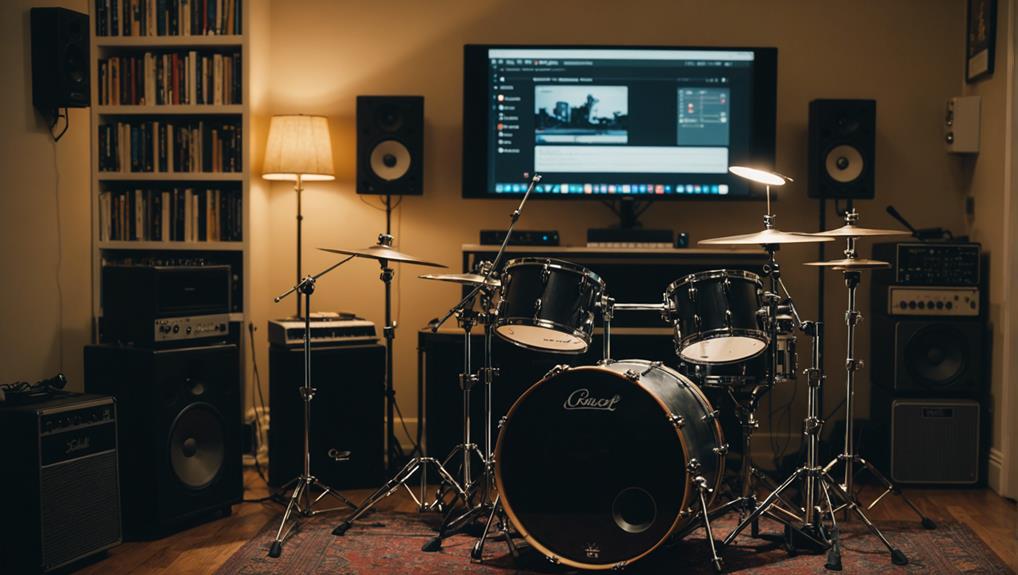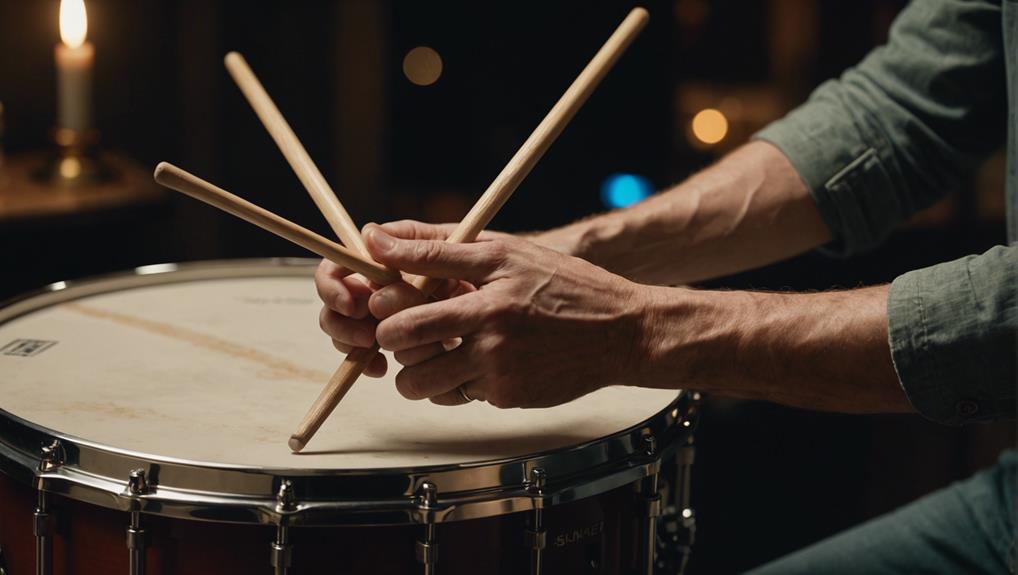If you’re looking to drum faster, you should start by mastering basic techniques that form the foundation of speed. Focus on exercises to improve finger control, wrist strength, and finger independence. Techniques like Moeller and bounce strokes can greatly enhance your efficiency. Using a metronome to set incremental BPM goals will help maintain steady timing. You’ll also need to work on endurance by practicing alternating notes and drum rudiments. But how do you guarantee that your weaker hand keeps up? The next steps will guide you through this important aspect of drumming faster.
TL-DR
- Use a metronome to incrementally increase BPM and improve timing.
- Practice finger control and wrist strengthening exercises to enhance speed.
- Incorporate the Moeller technique for efficient stick movement.
- Focus on playing ghost notes and accents to refine control and speed.
- Regularly practice drum rudiments and alternating note patterns to build endurance.
Master Basic Techniques

To drum faster, you must first master basic techniques like proper grip, stick control, and posture. These fundamentals are the foundation of your drumming journey. When you hold the drumsticks correctly, you allow for greater control and efficiency, translating into increased speed. Focus on your grip to make sure it’s firm but relaxed, minimizing tension that can slow you down.
Improving hand speed isn’t just about moving your hands faster; it’s about precise stick control and technique. Practice rudiments such as single strokes, double strokes, and paradiddles consistently. These exercises enhance your muscle memory, which is essential for achieving higher speeds. Your hands will naturally respond faster and more accurately with time, thanks to repeated practice.
Your posture also plays a significant role. Sitting correctly at the drum set ensures you can move fluidly and efficiently. Keep your back straight and shoulders relaxed to avoid unnecessary strain.
Coordination between your hands and feet is another critical aspect. Work on exercises that synchronize your limbs, helping you build speed and accuracy.
Use a Metronome
Using a metronome is essential for improving your drumming speed and precision. Start by setting incremental goals to gradually increase your tempo.
Practice consistently with the metronome to develop a solid sense of rhythm and achieve your speed targets.
Set Incremental Goals
Start by setting specific BPM goals with a metronome to accurately track your progress. Begin at a comfortable tempo where you can play your drum beats cleanly and without strain. This baseline will be your starting point.
To increase your speed, set incremental goals by raising the BPM slightly each session. For example, if you’re comfortable at 80 BPM, push it up to 85 BPM next. The key is to focus on these small, manageable increases.
Using a metronome helps you maintain steady timing and improve your rhythmic accuracy. It’s essential to play cleanly and accurately at each speed level before moving on. Don’t rush this process; making sure each increment feels natural ensures you’re building a strong foundation.
As you advance, your muscle memory will develop, making it easier to handle faster tempos. Consistent practice with the metronome will solidify these skills. It might seem slow at first, but these incremental goals are vital for sustainable progress.
Always prioritize quality over speed. By gradually increasing your BPM goals, you’ll find that your ability to play faster and more accurately will improve significantly over time.
Practice Consistently
Incorporating consistent practice with a metronome guarantees you develop precision and timing in your drumming. A metronome is an indispensable tool that helps you build muscle memory for faster tempo changes. By practicing with a metronome, you can make sure your tempo remains steady, which is vital for both live performances and studio recordings.
Here’s how you can effectively use a metronome to enhance your drumming skills:
- Start Slow: Begin at a slower tempo to focus on accuracy before increasing speed. This will help you develop precise timing.
- Gradual Increases: Incrementally raise the tempo as you become comfortable, allowing your muscle memory to adapt to faster speeds.
- Track Progress: Regularly monitor your improvements by noting the tempos you can play comfortably. This will help you see tangible progress.
- Use Visual and Audible Cues: Take advantage of the metronome’s visual and audible cues to stay on beat and maintain consistent rhythm.
Consistent metronome practice not only improves your speed but also enhances your overall drumming skills. As you track your progress, you’ll notice a significant boost in your ability to handle faster tempos with precision and control.
Improve Stick Control

Mastering stick control is essential for drummers aiming to boost their speed and precision. By focusing on your drumming hand, you can refine your stick control, which is a fundamental aspect of drum technique. Speed comes with the right practice routine and hand technique. Start by examining your grip and ensuring it’s relaxed but firm. This allows for better control and less fatigue.
Incorporate exercises that emphasize rebound and wrist control. These can be as simple as single-stroke rolls or more advanced patterns like paradiddles. The key is consistency and attention to detail. Proper stick control enhances your dynamics and articulation, making your drumming sound more polished and professional.
Techniques such as finger control, the Moeller technique, and bounce strokes are invaluable. Finger control helps you make quick, precise movements, while the Moeller technique utilizes natural arm motion for power and speed. Bounce strokes teach you to use the stick’s natural rebound, reducing effort.
Don’t rush the process. Slow, deliberate practice builds the foundation for faster, more fluid drumming. Dedicate time in your practice routine to focus solely on stick control. Over time, you’ll notice significant improvements in your speed and overall performance quality.
Enhance Hand Speed
To enhance your hand speed, focus on mastering finger control techniques and incorporating wrist strength exercises into your practice routine.
You’ll find that these methods not only boost your speed but also improve your overall control and precision.
Consistent practice will help you achieve faster and more dynamic drumming.
Finger Control Techniques
Finger control techniques are essential for drummers looking to boost their hand speed and play intricate patterns with precision. By focusing on the dexterity and strength of your individual fingers, you can achieve faster rhythms and maintain control over your playing. Mastering finger technique allows you to execute ghost notes, accents, and complex fills with ease.
To enhance your hand speed and finger control, incorporate the following exercises into your practice routine:
- Finger Rolls: Practice rolling each finger on the stick to develop independence and strength.
- Single Finger Strokes: Isolate each finger by performing strokes using only one finger at a time. This helps in gaining precision and control.
- Finger Control Drills: Use a metronome to practice various finger control drills, gradually increasing the tempo to build speed.
- Ghost Notes and Accents: Focus on playing ghost notes and accents with your fingers, ensuring every stroke is deliberate and controlled.
Developing finger control is essential for enhancing overall hand speed. With consistent practice, you’ll find that you can play complex patterns effortlessly and with greater precision. Remember, the key to faster drumming lies in the control and agility of your individual fingers.
Wrist Strength Exercises
Enhancing your hand speed on the drums also requires building wrist strength, which complements the finger control techniques you’ve already mastered. Strong wrists are vital for improving hand speed and overall drumming performance.
Incorporate wrist curls and reverse wrist curls into your exercise routine. These exercises target different muscle groups in your forearms, enhancing both endurance and strength.
Wrist curls involve holding a lightweight dumbbell in each hand, palms facing up, and curling your wrists upwards. Reverse wrist curls are done similarly, but with palms facing down. Both exercises should be performed with controlled movements to guarantee proper technique and prevent injury.
Another excellent exercise for building wrist strength is the wrist roller. This tool helps develop endurance and strength by requiring you to roll a weight up and down using a handle and a rope. Consistent practice with the wrist roller will lead to noticeable improvements in your hand speed.
Focus on Coordination

Mastering coordination on the drum set means syncing your hands and feet to tackle complex rhythms with ease. To drum faster, you need to develop limb independence, allowing each limb to operate separately yet harmoniously. Start by isolating one hand and practicing simple patterns, gradually adding elements from the rest of the drum kit. This method will enhance your coordination and drumming speed.
Here are four steps to improve your coordination:
- Practice Basic Patterns: Focus on basic rhythmic patterns with one hand while keeping a steady beat with your foot. This helps build a foundation for more complex coordination.
- Play Polyrhythms: Experiment with polyrhythms, where each limb plays different rhythms simultaneously. This will challenge your brain and improve your limb independence.
- Use Different Configurations: Rearrange your drum kit periodically. It forces you to adapt and refine your coordination skills by changing the physical layout and requiring new movements.
- Play Along with Various Genres: Drumming to different music genres exposes you to diverse rhythmic structures, further honing your coordination abilities.
Build Endurance
To build endurance in drumming, you’ll need to practice alternating bars of 8th and 16th notes for around 10 minutes. This exercise helps you build stamina and get used to maintaining a consistent pace. It’s important to incorporate drum rudiments into your routine, as they form the foundation of your technique and improve your overall control.
Focus on your weaker hand during these sessions to make sure it catches up with your dominant hand. This balanced approach will help you increase speed over time. Don’t rush; patience is vital. Push your limits by playing 16th notes as fast as possible for 5 minutes. Doing so burns out your muscles, forcing them to adapt and grow stronger.
Consistency is essential. Dedicate regular practice time, at least 4 times a week, to these endurance exercises. Noticeable progress comes from persistent effort, so stick to your schedule. Over time, you’ll see that you can play faster and for longer periods without tiring.
Next up, learn how to teach yourself to drum in this guide.



